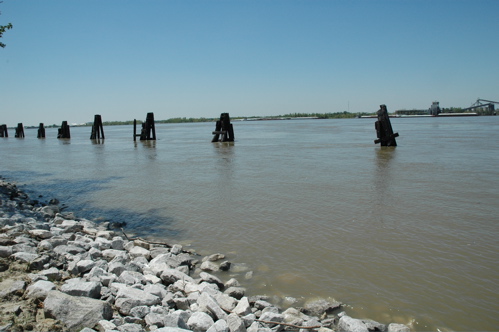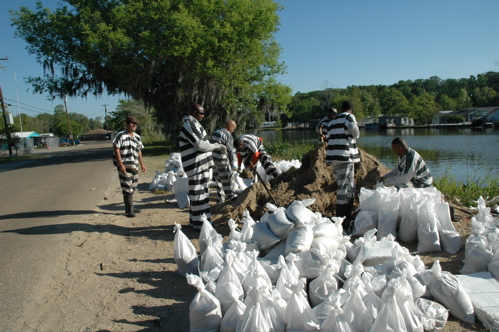Water stalks southern Louisiana like a panther seeking its prey. Hurricane Katrina was the kill, but the water never relents -- always moving, sometimes retreating, forever flowing. This week the National Weather Service issued a flood warning for New Orleans as record snow melts and spring rains flowed into the Mississippi River Basin. Feeding on strong northerly winds that carried record cold into the delta, rapid river crests are expected north of Baton Rouge in Greenville and Vicksburg. The choreography of the hunt reached perfection with a southerly shift in the winds and increased tidal flow in New Orleans, pushing and squeezing the water to "official" flood stages.
On Tuesday April 15, the Carrollton gauge at the Army Corps of Engineers office on Leake Avenue in midtown was inching toward 16.5 feet. New Orleans has an official flood stage of 17 feet, but the floodwalls and levees protect the city to over 20 feet, providing the winds and the rain and the flow cooperate.

The Corps of Engineers caught a lot of flack in the aftermath of Katrina, but there is another story of regular men and women doing a day to day job of maintenance and observation that gets overlooked in the flurry of media attention to the disaster -- meaning the disaster that was Katrina--an epic victory for the water which will forever haunt this area. Attention spans are short, both in the halls of Congress and in the mainstream media -- but the water does not yield.
Chris Accardo's office overlooks the Mississippi and the Carrollton flood gauge. Forty one percent of the nation's water flows past his window. Only the mighty Amazon and Congo Rivers have bigger watersheds. It's his job, as Chief of the New Orleans District Operations to make sure that the spring water flow does not exceed 1.25 million cubic feet per second. For some perspective on what that amount of flow means -- it would fill the Super Dome in one minute and forty seconds, according to published estimates. Accardo's fallback for now is the Bonnet Carré Spillway, which has an elaborate system of floodgates. As of April 16, 90 gates are open now, with more in reserve.

This is the first time in eleven years that Bonnet Carré was asked to do her job. The spillway is located 28 miles above New Orleans in St. Charles Parish. It was designed to manage approximately 1.9 million gallons of water per second. The decision to open Bonnet Carré is the responsibility of Mississippi River Commission.
Major Tim Kurgan, Corps media rep for the New Orleans' office, joined us for a conversation about the levee system, what's happening real time with the water flow, and the competing interests, which make flood management a decidedly dicey proposition.
There are actually two levee systems that protect human interests from nature's predation. The river levees, designed for high river events, held during Katrina, and have always held. They are expected to hold now, during what is expected to be a ten-year very high water event, albeit one that is spooking the area less than three years post Katrina.
Accardo is confident, but not cocky.
"We expect to be able to deal with this high water event and respond to any problems that may arise," he says.
"Louisiana was given billions for hurricane protection after Katrina, but those funds were for hurricane protection levees. The levees that we are relying upon for high river events are not covered by that money. The river levees are in better shape than the hurricane protection levees, and therefore do not require the amount of funds as the hurricane protection system."
"Northern Congressmen don't understand that we have two systems of levees down here. They don't want to keep throwing money down here when they have constituents up in their districts who have other projects in mind," Accardo added as his eyes scanned the expanse of river a hundred feet outside of his windows.
Accardo and Kurgan talked about a maintenance budget for the river levees that is essentially "flatlined." How did this happen?
Kurgan mentions that we are essentially "a reactive society." The national emphasis now is on hurricane protection at the expense of maintenance budgets.
"We are one disaster away from being yesterday's news," Accardo says. "It is the level of commitment for prevention that is essential. Look at Holland. After the floods there, they said 'never again' and the dike system is the best in world."
What about the Bonnet Carré Spillway? It was first opened during the flood of 1927 and only seven times since that date.
The Spillway was designed to take water out of the Mississippi and divert it to lake Pontchartrain. This presents problems for a brackish lake -- flooding it with freshwater -- and Accardo readily understands this.
In addition there are environmental concerns about the nutrient laden waters -- nitrogen and phosphorus washed downstream from the fertile farms of the North Country. Lake residents are concerned that opening the Bonnet Carré for too long will cause a repeat of an algae bloom that covered three quarters of the lake's surface, causing massive fish kills. While no one expects this to happen this year, it is an obvious concern nonetheless.
While Accardo recognizes the environmental concerns, his job is to manage river flow, and that is the bottom line. He lists the main threat to levee integrity as seepage, and this can occur through, under and over a levee. The Corps has crews out on the levees on a daily basis. What are they looking for?
"Sand boils" and areas of seepage are a harbinger of trouble. During ties of high flow, Accardo says, the flow gets pressed up against the levee, creating a hole. The water then backs up creating a watery "boil." Ignore it and it can cause a breach. How do you fix it? Sandbags surround the flow and reduce the pressure, thereby controlling the problem. Nothing threatening has been found so far, but the river detectives keep their watch.
Vigilance may be part of the answer, but more money would certainly fix it.
How much money would create a perfect world for maintenance of the levee system?
Accardo absorbs the question as if it makes no sense, and perhaps it doesn't.
First of all Congress does not seem interested in maintenance budgets for a river levee system that has held.
In addition, high water events present special challenges to barge navigation, which requires open, deep channels. As long as the velocity of the water remains high, sediment remains suspended and does not deposit in the navigation channel. However, the water flow slows as it approaches the Gulf, causing deposits of sediment. The Corps is responsible for keeping these waterways open, and that costs money. In addition, the thought of a barge hitting a levy and causing a breach is a real concern.
Accardo explained that the Corps is running five dredges in the southwest pass to maintain a navigation channel.
Hopper Dredges that can deepen the channels cost hundreds of millions of dollars to purchase and operate. Fuel costs have tripled in the last ten years.
Private contractors who operate their own fleets of dredges depend upon government contracts, so no one wants to have high price equipment sitting in dry dock. There is a delicate balance to maintain between the government fleet and private interests.
Accardo's biggest enemy is not the water. It is misconceptions about the importance of maintenance and the fact that he has no mandate, legal or otherwise, to lobby Congress and raise awareness in the rest of the country about what it takes to manage forty one percent of the nations' water flow.
Meanwhile, on the backwaters and bayous of southern Louisiana, the water continues its stealthy surge. Jogging the roads of Stephensville outside of Morgan City, one hears a blurp and an gurgle where there was none the day before, and the water is inches closer to the narrow road that bisects bayou and cypress swamp.
Shorebirds are flocking to the backwaters, snakes and armadillos are on the move, alligators jump, and the whine of pumps can be heard along with the frogs, crickets and cicadas. The feathered remnants of a crushed hawk with a fish in its mouth float downstream, along with the skeleton of what was once a dog.
The prison crew from St. Martinsville, under the watchful eyes of a deputy, is sandbagging the Stephensville road. The men wear black striped suits that call to mind another era. The men are jovial, laughing, and don't mind the Yankee taking a photo or two. Do prisoners still wear black stripes?

A family down the road is filling white plastic bags from the sand pile near the swing bridge. Mom and dad stand in the back of the weathered battered grey pickup bed, while the kids fill the bags and drag them over. No one talks. Shovel, drag, and lift.
The panther moves, stalking, flowing, and relentless.